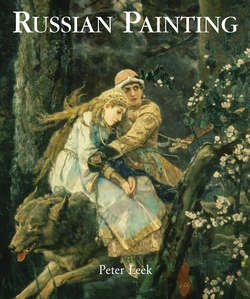Читать книгу Russian Painting - Peter Leek - Страница 8
На сайте Литреса книга снята с продажи.
Introduction
The emergence of Russian Avant-garde
ОглавлениеDuring the first quarter of the twentieth century, modern Russian painters wished to confer upon art a vaster social resonance. To this end, they had to reconcile the profound attachment of Russians to tradition and the desire for renewal. The latter found expression in a wide variety of movements. Russian avant-garde offers multiple facets, drawing inspiration from foreign sources as well as those of its home country, making Russian art the spearhead of the worldwide artistic process at the beginning of the twentieth century.
A hundred years or so later, Sergeï Shchukin and the brothers Mikhaïl and Ivan Morozov purchased numerous Impressionist paintings and brought them back to Russia. In 1892 the merchant and industrialist Pavel Tretyakov gave his huge collection of paintings (including more than a thousand by Russian artists) to the city of Moscow. Six years later, the Russian Museum opened in the Mikhaïlovsky Palace in Saint Petersburg. Today it houses more than 300,000 items, including some 14,000 paintings.
Exhibitions, such as that of Tretyakov in the Russian Museum, also played an important role in the development of Russian art. At the end of the nineteenth century, the artistic status of icons had been in eclipse for approximately two hundred years, even though they were cherished as objects of religious veneration. During that time, many of them had been damaged, inappropriately repainted or obscured by grime. In 1904, Rublev’s Old Testament Trinity was restored to its full glory, and in 1913 a splendid exhibition of restored and cleaned icons was held in Moscow to mark the millennium of the Romanov dynasty. As a result, the rediscovered colours and stylistic idiosyncrasies of icon painting were explored and exploited by a number of painters in the first decade or two of the twentieth century. Similarly, when Diaghilev mounted a huge exhibition of eighteenth-century portrait painting at the Tauride Palace in Saint Petersburg in 1905, it resulted in a noticeable revival of interest in portraiture and in Russia’s artistic heritage as a whole. International exhibitions (like the ones organized by the Golden Fleece magazine in 1908 and 1909), together with foreign travel and visits by foreign artists to Russia, allowed Russian painters to become acquainted with movements such as Impressionism, Symbolism, Futurism and Cubism. What is particularly fascinating is to see how artists as diverse as Grabar, Vrubel, Chagall, Larionov and Goncharova adapted these influences and used them to create their own art – often incorporating Russian elements in the process.
9. Nikolaï Souetine, Esquisse de peinture murale. Vitebsk. 1920. Chinese Ink on paper. 20.3 × 18.2 cm.
